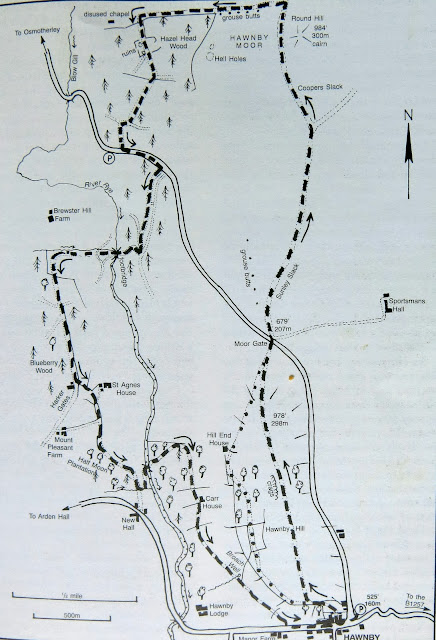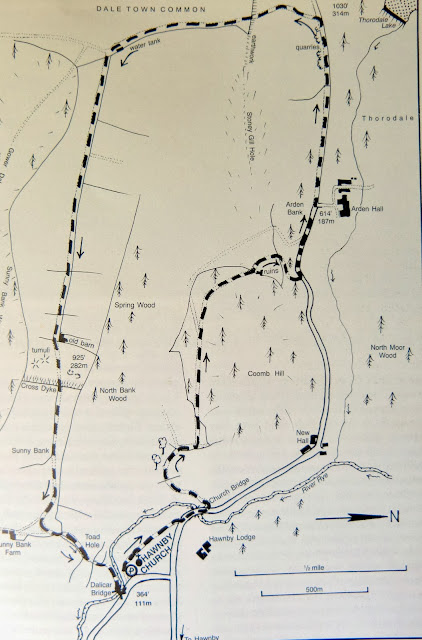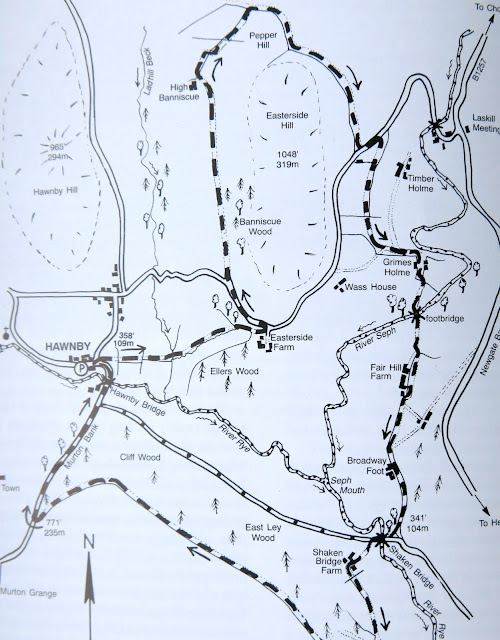Hawnby Hill and Hazel Head from Hawnby
7 miles High cloud, dry and fairly warm
Our third walk from Hawnby in as many weeks, this time from the top of the village where we parked in a small car park near to the Inn at Hawnby.
TSB's map of today's walk from The Walker's Guide to the Hambleton Hills
The village sits under Hawnby Hill, (298m) the twin of Easterside Hill that we walked round a couple of weeks ago. These two hills, known as Corallian Outliers, once formed part of the Tabular Hills. We left the road opposite the Inn and immediately started to climb across a field, then through bracken until we reached the top of Hawnby Hill. From here there is a good view in all directions, to the left down to Arden Hall and to the right Easterside Hill. We walked along the long ridge identifying places we had passed on our previous walks.
Looking back towards Hawnby as we near the top of Hawnby Hill
Looking to the left we see Arden Hall amongst the trees
The view ahead along the ridge of Hawnby Hill
To the right is Easterside Hill
Just before the end of the ridge the path bears right and then drops down to Moor Gate and the road. We crossed the road and joined a sandy track for a couple of miles. As we walked we saw a gamekeeper's 4x4 with dead rabbits in a box but no sign of the gamekeeper even though we could see for miles in all directions.
Looking back from Hawnby Moor towards Hawnby Hill
Gamekeeper's 4x4...
...and its grisly cargo!
Reaching Round Hill our path turned left from the main track and we walked towards Hazel Head Wood. Just before we entered the wood we found some crater like holes that were sheltered and facing towards the ruins of an old barn. We sat here and enjoyed our coffee and scones while referring to the Walker's Guide to the Hambleton Hills where Tom Scott Burns informed us that these craters were known as 'Hell Holes' in the past but were actually formed by different grits in the strata being dissolved by water. He also mentioned that the ruined barn had once been used as a Wesleyan Chapel.
Walking towards Hazel Head Wood
Looking down from our coffee stop towards the old barn
A gate led us into the woods and a faint track led us past more ruins, the long abandoned Hazel Head Farm. The ground was very damp and sunlight didn't penetrate the trees and we were interested in the numerous types of fungi growing everywhere we looked.
Ruin of Hazel Head Farm
We came out of the woods onto the road near to Hazel Head Car Park before re-entering the trees of Ellers Wood. All along this stretch of woodland are bird feeders and we were constantly surprised as startled pheasants took to the air in large numbers.
A grim warning - dead crows tied near to bird feeders
The wide path loses height and eventually led us to the River Rye where forestry vehicles could obviously pass through a foot or so of water, but we searched for the footbridge mentioned by TSB. We quickly found it and backtracked slightly on the forestry path to fight our way through the bracken and brambles to reach the bridge, which is obviously little used by walkers.
Hidden bridge
Clives checks the map!
We followed our path upwards alongside a beck and then the trees of Blueberry Wood before dropping down past St Agnes House and Half Moon Plantation and to a large arched footbridge over the River Rye. We wondered why someone had gone to the expense of this unusual bridge at this quiet spot. Perhaps a danger of flooding requires an arched bridge?
Large arched footbridge over the River Rye
View upriver from the footbridge
A quick scramble upwards led us to a well defined path that runs alongside the trees, taking us through field after field of cattle until we suddenly dropped back down onto the Hawnby Road and the awaiting Inn at Hawnby.
Looking up at Hill End House from our trail
Our path gets fainter
Walk over, the view from The Inn at Hawnby



























































